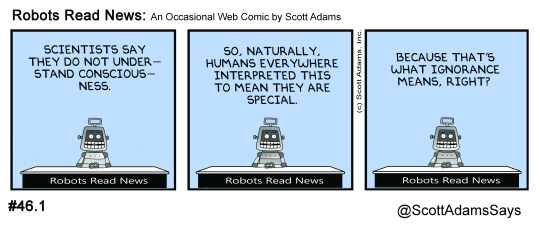
Lubos Motl defends the Copenhagen interpretation of quantum mechanics, and now he defends the Von Neumann–Wigner interpretation. Von Neumann supposedly believed that human consciousness caused collapse of the wave function, and Wigner said he thought that a dog had sufficient consciousness to cause collapse.
It sounds ridiculous when you phrase it that way, but it is not so silly. The electron may have an independent objective existence, but our best explanation uses wave functions that cleverly encode how it was observed in the past and how it might be observed in the future.
The Moon exists whether we look at it or not, but the exact position and other physical characteristic are either directly observed or inferred from models and previous observations. The observations confirm the predictions and narrow the error bars.
And yes, a dog can look at the Moon.
Peter Woit cites an ex-string theorist ranting about the field. One notable point is that hardly anyone is really doing string theory any more. They are toying around with mathematical structures and models inspired by string theory, but they are not trying to study electrons as tiny strings or anything you might recognize from popular accounts of the field.
Scott Aaronson has joined Noam Chomsky and other MIT eggheads in denouncing investment in oil companies. Some of the comments explain how this is just feel-good leftist political posturing that will accomplish nothing worthwhile. You would think that all these smart MIT professors could recommend some constructive changes for our society.
Sometimes I think that the environmentalist movement is dominated by anti-environmentalists who invent stupid causes to distract people away from bigger threats.
A gallon of gasoline is cheaper than a gallon of bottled water and they complain.
ReplyDeleteDear Roger,
ReplyDeleteAs you know, formulated in 1926 by Erwin Schroedinger, a partial differencial equation that describes how the quantic state of a physical system changes with time. For it, in 1933, he received the Nobel Prize (together with Paul Dirac). It contains the term Ψ, refered somewhat improperly as "wave function". The significance of it was not understood, untill Max Born interpreted it as defining the probability of finding a particle in a determinate place of space. He received the Nobel Prize for itin 1932. The possibility can be represented by a Gauss curve, with maximum in the center and coming assyntotically to zero int he extremities. The mathematical formalism adopted leaves clear that in the instant the location of the particle is made, all probabilities desapear. Stangelly, since the formulation to this day, numerous discussions about the significance of this disapearance occur, maintaining that there is something misterious in it. Nevertheless, when we have a dice in hand before we throw it the possibility of each face falling upside is one to six. In the moment it falls upon the table and immobilize, it's clear one can nomore speak in probabilities, as one of the faces was defined. Its obvious, there is nothing misterious in it, as even Einstein and Niels Bohr concurred.
It's what occurs when one imagines Physics necessarilly must be described by mathematical formulas, even when they are not needed, as is the case. In this love by mistery, even today is frequent the undertanding that the wave function significs that the particle is in all places at the same time, and quantic theory makes possible the creation on a computer capable of realizing simultaneously infinite mathematical operations, a thing that would be useful, by instance, in braking chiptographed texts.
Another common mistake that has the same origin consists in Hugh Everett's "multiple universes interpretation", that erroniously affirms the objective reality of the universal wave function.
Fernando Arthur Tollendal Pacheco
fernandoarthur@gmail.com